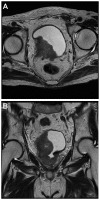Determining the optimum way to maintain quality of life for very elderly patients with advanced bladder cancer and poor performance status: A case report
- PMID: 28588799
- PMCID: PMC5451885
- DOI: 10.3892/mco.2017.1236
Determining the optimum way to maintain quality of life for very elderly patients with advanced bladder cancer and poor performance status: A case report
Abstract
Locally advanced bladder cancer causes unpleasant symptoms such as irritative voiding symptoms, lower abdominal pain, gross hematuria and urinary retention, and lowers the quality of life. Treatment decisions in elderly patients may be difficult, as elderly patients are physically and psychologically different from younger patients. An 89-year-old male was referred to hospital for the treatment of an invasive bladder tumor with right hydronephrosis from tumor obstruction. The patient was elderly and did not have a good performance status; therefore curative radical cystectomy or chemotherapy was not indicated. Left retroperitoneoscopic ureterocutaneostomy was performed to alleviate gross hematuria and voiding difficulty. Intensity-modulated radiotherapy was administered 9 days after the surgery to control bleeding in the bladder tumor. After completing 8 days of radiotherapy, the patient was discharged from hospital. The patient exhibited no signs of either postrenal failure or gross hematuria for 7 months prior to mortality. Retroperitoneoscopic ureterocutaneostomy for very elderly patients with advanced bladder cancer with a poor performance status may be an important procedure for alleviating symptoms and improving quality of life.
Keywords: elderly patient; gross hematuria; invasive bladder cancer; palliative treatment; retroperitoneoscopic ureterocutaneostomy.
Figures



Similar articles
-
Retroperitoneoscopic ureterocutaneostomy for obstructive uropathy with advanced bladder cancer: a case report.Int J Urol. 2002 Jan;9(1):60-2. doi: 10.1046/j.1442-2042.2002.00420.x. Int J Urol. 2002. PMID: 11972653
-
Palliative radiation therapy of symptomatic recurrent bladder cancer.Pain Physician. 2007 Mar;10(2):285-90. Pain Physician. 2007. PMID: 17387350
-
[Results of radical cystectomy for management of invasive bladder cancer with special reference to prognostic factors and quality of life depending on the type of urinary diversion].Ann Acad Med Stetin. 2000;46:217-29. Ann Acad Med Stetin. 2000. PMID: 11712306 Polish.
-
Quality of Life in Elderly Bladder Cancer Patients Following a Cystectomy.Adv Exp Med Biol. 2017;989:297-300. doi: 10.1007/978-3-319-57348-9_28. Adv Exp Med Biol. 2017. PMID: 28971439 Review.
-
[Treatment for locally advanced bladder cancer in elderly patients].Hinyokika Kiyo. 2005 Aug;51(8):553-7. Hinyokika Kiyo. 2005. PMID: 16164272 Review. Japanese.
References
LinkOut - more resources
Full Text Sources
Other Literature Sources
